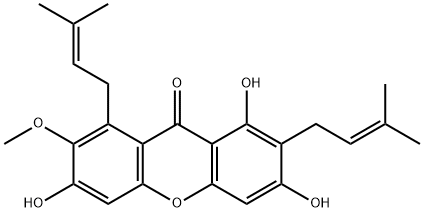Mangostin
- CAS NO.:6147-11-1
- Empirical Formula: C24H26O6
- Molecular Weight: 410.46
- MDL number: MFCD00135200
- EINECS: 683-120-1
- SAFETY DATA SHEET (SDS)
- Update Date: 2024-11-29 14:36:51

What is Mangostin?
Description
α-Mangostin (6147-11-1) is a xanthone natural product that has historically been used in traditional folk medicine.1 It is a potent agonist of human STING (Stimulator of Interferon Genes) and also weakly activates mouse STING.2 Induces IFN-β production and repolarizes human monocyte-derived M2 macrophages to M1. Improves insulin secretion and protects INS-1 cells from streptozotocin-induced damage.3 Suppresses the metastasis of human renal carcinoma cells.4 Synergizes with kinase inhibitors in suppression of proliferation of SK-MEL-2 malignant melanoma cells.5
Chemical properties
Yellow Crystalline Solid
The Uses of Mangostin
α-Mangostin has been used:
- to study its protective effect against oxidative stress mediated-retinal cell death
- to study its role as an antigenotoxic agent in DNA protection against oxidative damage
- to understand its anti-bacterial activity against Staphylococcus epidermidis?RP62A
The Uses of Mangostin
It was isolated from Garcinia mangostana Linn (Guttiferae). It is an anti-inflammatory agent
The Uses of Mangostin
antifungal, antilarval
What are the applications of Application
Mangostin is an anti-inflammatory agent
Definition
ChEBI: Alpha-mangostin is a member of the class of xanthones that is 9H-xanthene substituted by hydroxy group at positions 1, 3 and 6, a methoxy group at position 7, an oxo group at position 9 and prenyl groups at positions 2 and 8. Isolated from the stems of Cratoxylum cochinchinense, it exhibits antioxidant, antimicrobial and antitumour activities. It has a role as an antineoplastic agent, an antimicrobial agent, an antioxidant and a plant metabolite. It is a member of xanthones, a member of phenols and an aromatic ether.
General Description
This substance is a primary reference substance with assigned absolute purity (considering chromatographic purity, water, residual solvents, inorganic impurities). The exact value can be found on the certificate. Produced by PhytoLab GmbH & Co. KG
Biochem/physiol Actions
Xanthone derivative isolated from mangosteen (Garcinia mangostana). Antioxidant and anti-inflammatory. α-mangostin has been shown to induce apoptosis via the mitochondrial pathway, reduce cell proliferation and inhibit tumorigenesis.
storage
Store at -20°C
References
1) Mohan et al. (2018), An anti-inflammatory molecular mechanism of action of α-mangostin, the major xanthone from the pericarp of Garcinia mangostana: an in silico, in vitro and in vivo approach; Food Funct., 9 3860 2) Zhang et al. (2018), Identification of α-Mangostin as an Agonist of Human STING; Chem. Med. Chem.,?13 2057 3) Lee et al. (2018), Alpha-Mangostin Improves Insulin Secretion and Protects INS-1 Cells from Streptozotocin-induced Damage; J. Mol. Sci., 19 E1484 4) Chen et al. (2017), Alpha-Mangostin Suppresses the Metastasis of Human renal Carcinoma Cells by Targeting MEK/ERK Expression and MMP-9 Transcription Activity; Cell Physiol. Biochem., 44 1460 5) Xia and Sun (2018), Synergistic inhibition of cell proliferation by combined targeting with kinase inhibitors and dietary xanthone is a promising strategy for melanoma treatment; Clin. Exp. Dermatol., 43 149
Properties of Mangostin
| Melting point: | 180-182°C |
| Boiling point: | 640.1±55.0 °C(Predicted) |
| Density | 1.265±0.06 g/cm3(Predicted) |
| storage temp. | 2-8°C |
| solubility | methanol: soluble1mg/mL, clear, very light yellow |
| form | powder |
| pka | 7.22±0.20(Predicted) |
| color | faint yellow to yellow |
| λmax | 346nm(MeOH)(lit.) |
| Stability: | Stable for 2 years from date of purchase as supplied. Solutions in DMSO may be stored at -20°C for up to 1 month. |
| InChI | InChI=1S/C24H26O6/c1-12(2)6-8-14-16(25)10-19-21(22(14)27)23(28)20-15(9-7-13(3)4)24(29-5)17(26)11-18(20)30-19/h6-7,10-11,25-27H,8-9H2,1-5H3 |
| CAS DataBase Reference | 6147-11-1(CAS DataBase Reference) |
Safety information for Mangostin
| Signal word | Danger |
| Pictogram(s) |
 Skull and Crossbones Acute Toxicity GHS06 |
| GHS Hazard Statements |
H301:Acute toxicity,oral |
Computed Descriptors for Mangostin
| InChIKey | GNRIZKKCNOBBMO-UHFFFAOYSA-N |
| SMILES | C1(=O)C2=C(C=C(O)C(OC)=C2C/C=C(/C)\C)OC2=C1C(O)=C(C/C=C(/C)\C)C(O)=C2 |
New Products
Tert-butyl bis(2-chloroethyl)carbamate 4-Methylphenylacetic acid N-Boc-D-alaninol N-BOC-D/L-ALANINOL N-octanoyl benzotriazole 3-Morpholino-1-(4-nitrophenyl)-5,6-dihydropyridin- 2(1H)-one Furan-2,5-Dicarboxylic Acid DIETHYL AMINOMALONATE HYDROCHLORIDE 1,1’-CARBONYLDIIMIDAZOLE R-2-BENZYLOXY PROPIONIC ACID 1,1’-CARBONYLDI (1,2-4 TRIAZOLE) N-METHYL INDAZOLE-3-CARBOXYLIC ACID (2-Hydroxyphenyl)acetonitrile 4-Bromopyrazole 5-BROMO-2CYANO PYRIDINE 5,6-Dimethoxyindanone 5-broMo-2-chloro-N-cyclopentylpyriMidin-4-aMine 2-(Cyanocyclohexyl)acetic acid 4-methoxy-3,5-dinitropyridine 1-(4-(aminomethyl)benzyl)urea hydrochloride 2-aminopropyl benzoate hydrochloride diethyl 2-(2-((tertbutoxycarbonyl)amino) ethyl)malonate tert-butyl 4- (ureidomethyl)benzylcarbamate Ethyl-2-chloro((4-methoxyphenyl)hydrazono)acetateRelated products of tetrahydrofuran








You may like
-
 α-Mangostin CAS 6147-11-1View Details
α-Mangostin CAS 6147-11-1View Details
6147-11-1 -
 α-Mangostin CAS 6147-11-1View Details
α-Mangostin CAS 6147-11-1View Details
6147-11-1 -
 Alpha-mangostin 95% CAS 6147-11-1View Details
Alpha-mangostin 95% CAS 6147-11-1View Details
6147-11-1 -
 α-Mangostin CAS 6147-11-1View Details
α-Mangostin CAS 6147-11-1View Details
6147-11-1 -
 Mangostin CAS 6147-11-1View Details
Mangostin CAS 6147-11-1View Details
6147-11-1 -
 14714-50-2 (2-Hydroxyphenyl)acetonitrile 98+View Details
14714-50-2 (2-Hydroxyphenyl)acetonitrile 98+View Details
14714-50-2 -
 118753-70-1 98+View Details
118753-70-1 98+View Details
118753-70-1 -
 733039-20-8 5-broMo-2-chloro-N-cyclopentylpyriMidin-4-aMine 98+View Details
733039-20-8 5-broMo-2-chloro-N-cyclopentylpyriMidin-4-aMine 98+View Details
733039-20-8